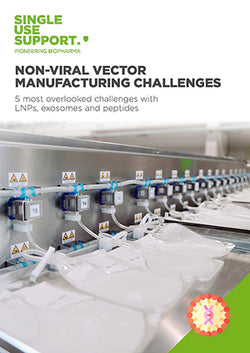Lipid nanoparticles toxicity: What to consider?
LNPs are used in various applications in medicine and other life sciences, e.g. as non-viral vectors for mRNA. However, lipid nanoparticle toxicity is a topic that needs to be addressed more closely. The structure of lipid nanoparticles and reactions of lipids and liposomes with different constituents has become an important field of research.
In this article, we will take a closer look at what to consider when working with lipid nanoparticles, how they are structured and what factors influence their toxicity.
Lipid nanoparticles – taking a look at their structure
The size of lipid nanoparticles varies between 10 and 1000 nanometers. Nanoparticle formulations typically consist of solid and liquid lipids which are stabilized by emulsifiers. Lipids used for lipid nanoparticles are phospholipids, cholesterol, polymers like PEGylated lipids and ionized, catatonic lipids which are liposoluble and water-soluble. When the desired ratio between these lipids is established, lipid nanoparticles are able to enclose drug molecules and transport them safely to the specific cell lines.

Particle size and special characteristics qualify lipid nanoparticles as carriers for mRNA, which encodes an antimicrobial peptide or small molecule inhibitors used for the treatment of different diseases, e.g. breast cancer. Lipids can improve particle stability and biodistribution in nanoparticles. LNPs deliver the payloads to the intracellular target and are easily absorbed by cells via endocytosis or phagocytosis, as their cell membrane also consists of lipids. Once the LNP is absorbed and entered the cytoplasm, the lipid encapsulation is broken down and the payload is released, which leads the cell to produce antibodies.
There are two major types of lipid nanoparticles: Solid lipid nanoparticles (SLN) and nanostructured lipid carriers (NLC), with differences in their structure.
Different types of lipid nanoparticles for life sciences
The demand for different types of lipid nanoparticles is constantly increasing. Due to the characterization of SLNs and NLCs, they are not only used successfully as drug delivery systems for immunogenicity and anticancer therapeutics, but can be found throughout different industries like gene transfer, cosmetics or food production. [[1]]
During the development of new drugs, it can be a challenge to replicate in vivo what shows great effects under in vitro conditions. [[2]] Reasons for the failure of new biologics range from poor absorption rates to toxic effects, failed immune responses due to low drug concentrations and insufficient cellular uptake or fluctuating plasma levels due to unpredictable bioavailability. Hence, the development for effective nanocarriers is in high demand. When talking about drug and nanoparticle combinations through nanotechnology, they are therefore often referred to as nanomedicine.
A recent example of the importance of LNPs in the treatment of diseases is the development of the Covid-19 vaccine. LNPs are used as carrier systems for messenger RNA encoding the receptor binding domain and have the ability to protect the nucleic acid from degradation before cellular uptake. [[3]] As non-viral vectors with the absence of immunogenic viral proteins, they are exceptionally safe in use. [[4]]
Further, LNPs are used to transport cytotoxic payloads to cancer cells. Through their targeting qualities, it becomes possible to deliver anticancer drugs directly to the targeted cells without harming healthy cells in the process. They are used in the therapeutics for advanced ovarian cancer, multiple myeloma, and HIV-associated Kaposi's sarcoma. [[1]] [[2]] [[3]] [[4]] [[5]]
Are lipid nanoparticles toxic? Factors to be aware of
Although lipid-based nanocarriers are considered one of the most effective drug delivery biomaterials [[6]] for gene delivery and are known as a safe alternative to viral vectors as nanocarriers in gene therapy and other applications, concerns towards their toxicological status and their behavior in the human body have emerged in the past.
Compared to other drug carriers, they are considered less toxic and immunogenic, due to them being biocompatible and biodegradable. As they are relatively new, physicochemical assays regarding the safety of their characteristic properties have yet to be established to fully understand the relationship of cell proliferation and cytotoxicity levels and LNP formulation.
In the following, we will pay a closer look at the state of research and facts about the factors that could influence toxicity levels in nanoparticle-based drugs. [[6]]
Structure and formulation
There are different methods to minimize unwanted side effects due to toxicity and unwanted responses of the immune system, in regards to structure and formulation of lipid nanoparticles in medicine. Toxicity levels depend on composition, combination with solvents for dilutions, particle size and particle charge of liposomes. Consequently, these factors have to be considered when choosing liposomes for nanomedicine.
Concentration
The main concern with lipid nanoparticles at the moment is related to their accumulation in the body. Nanoparticles with no or little solubility can accumulate quickly and can cause unwanted biological interactions. The same is true for particles that are non-degradable. However, there is not enough research data on cell viability to predict the possible effects of accumulations of LNPs at the moment. [[7]]
Additional factors for LNP toxicity
The clinical evaluation of lipid nanoparticles is still a work in progress. Since the first LNP for siRNA delivery was approved by the FDA in 2018, many more have entered clinical trials. Still, here is a need for effective assays to measure contaminating substances in order to prevent toxic side effects associated with nanoparticles. One effective strategy is the determination of toxicity in lipid particles through fluorescence-activated microscopy. [[8]]
There are different methods for nanoparticle toxicity assessments:
- chemical composition and surface property characterization
- nanoparticle evaluation under physiological conditions
- cellular and non-cellular in vitro toxicity assays
- assays based on animal models
LNP toxicity – current state of research
The effects of lipid-based nanoparticles in regards to size distribution, accumulation, metabolism and organ specific toxicity are considered to be minimal by today’s state of research. However, these and more factors like size dispersion have to be included in pharmacological assessment of any new LNP to evaluate possible negative effects.
Even though surface charge in lipids can prevent aggregation, tests with cationic lipids with positive surface charges on mice have been proven to alter bioactive components in the gastrointestinal tract and can lead to macrophages mediated toxicity, apoptosis, inflammatory cytokines and increased liver enzyme release. These effects occurred partly due to stabilizing surfactants.
The research on colloidal LNP toxicity today still shows major gaps, as there are almost no studies on the effects of nanoparticles on the environment. [[9]] [[10]]
Toxicity in LNP manufacturing
Speaking of LNP toxicity, one mainly refers to potential damages in the human body. Nevertheless, LNPs themselves are considered to be widely safe during manufacturing, also depending on other substances involved in the process.
However, LNPs need to be kept stable and sterile, which is why LNP manufacturers often rely on automated, closed processes. They allow for a high level of standardization, ensuring process consistency and product quality.
[[download-1]]
Overcoming LNP manufacturing challenges
Apart from concerns regarding toxicity of LNPs, there are further challenges that need to be addressed to let them reach their full potential for the pharma sector.

LNP manufacturing is one important aspect. Firstly, particle size and distribution has to be controlled. Secondly, sterilization and regulatory requirements, such as cGMP regulations, have to be addressed. The third issue regards process reproducibility through accurate characterization and scalability of nanomaterials.
With fully automated solutions by Single Use Support, it becomes easy to minimize the risk for contamination and human errors during the manufacturing process. For instance, dedicated single-use solutions help to make fluid management more efficient and safe. And with products to protect single-use bags, freeze-thaw techniques and single-use-filtration, Single Use Support makes sure that sensitive drug products are handled with care and responsibility, saving time and lowering costs.
References
- Solid Lipid Nanoparticles and Nanostructured Lipid Carriers: Structure, Preparation and Application, http://dx.doi.org/10.15171/apb.2015.043, Published 2015-09-28
- Solid lipid nanoparticles, http://dx.doi.org/10.1016/j.addr.2012.09.021, Published 2012-09-13
- Lipid nanoparticles for mRNA delivery, http://dx.doi.org/10.1038/s41578-021-00358-0, Published 2021-08-10
- Lipid Nanoparticles for Gene Delivery, http://dx.doi.org/10.1016/B978-0-12-800148-6.00002-X, Published 2014-11-16
- Lipid-based nanoparticles for treatment of cancer, http://dx.doi.org/10.1016/j.heliyon.2022.e09403, Published 2022-05-13
- Development of lipid nanoparticles and liposomes reference materials (II): cytotoxic profiles, https://www.ncbi.nlm.nih.gov/pmc/articles/PMC9610362/, Published 2022
- Toxicological considerations when creating nanoparticle-based drugs and drug delivery systems, http://dx.doi.org/10.1517/17425255.2012.637916, Published 2011-11-19
- Toxicological considerations when creating nanoparticle-based drugs and drug delivery systems, https://ec.europa.eu/health/scientific_committees/opinions_layman/es/nanotecnologias/l-3/6-health-effects-nanoparticles.htm, Published 2006
- The systemic toxicity of positively charged lipid nanoparticles and the role of Toll-like receptor 4 in immune activation, http://dx.doi.org/10.1016/j.biomaterials.2010.05.027, Published 2010-06-14
- The potential environmental impact of engineered nanomaterials, http://dx.doi.org/10.1038/nbt875, Published 2003-09-30

Download guide
Guide: Challenges in Non Viral Vector Manufacturing
Guide about navigating 5 of the most overlooked challenges in non-viral vector manufacturing with regards to fluid management challenges, such as degradation and instability of LNP during freezing, scalability concerns in exosome manufacturing or protection against toxic solvents in peptide manufacturing.
